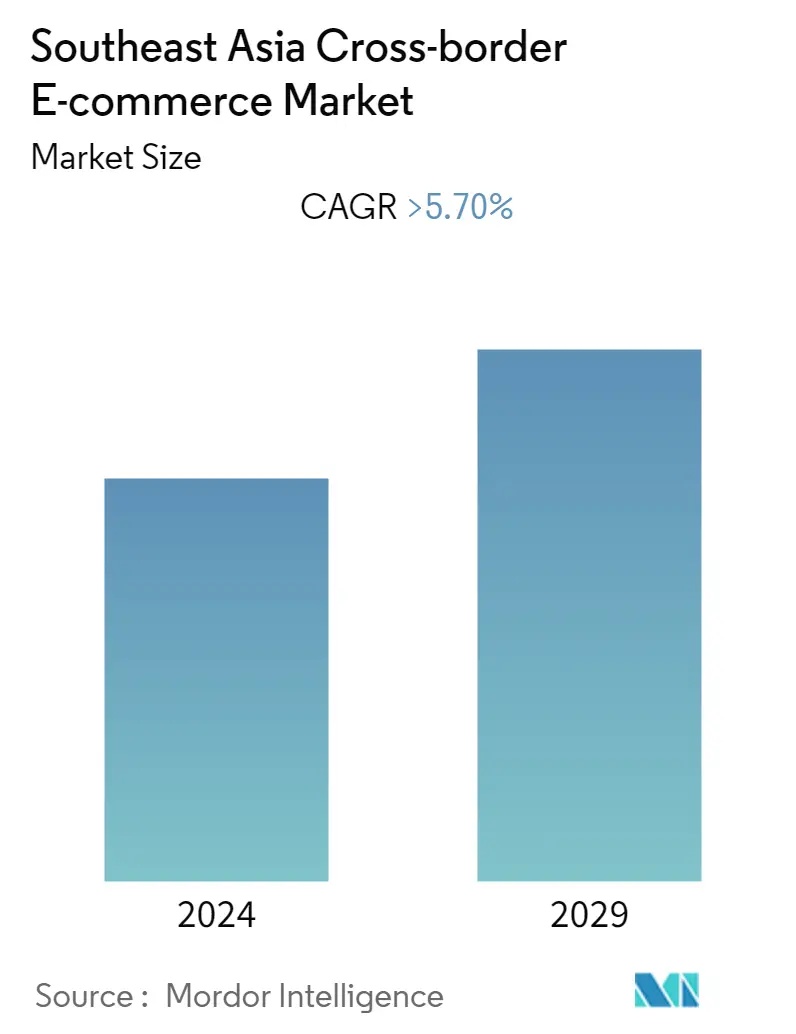Market Size of Southeast Asia Cross-border E-commerce Industry

| Study Period | 2019 - 2029 |
| Base Year For Estimation | 2023 |
| Forecast Data Period | 2024 - 2029 |
| Historical Data Period | 2019 - 2022 |
| CAGR | > 5.70 % |
| Market Concentration | Low |
Major Players
*Disclaimer: Major Players sorted in no particular order |
Need a report that reflects how COVID-19 has impacted this market and its growth?
Southeast Asia Cross-border E-commerce Market Analysis
The size of the Southeast Asia Cross-border E-commerce market is USD 13.5 billion in the current year and is anticipated to register a CAGR of over 5.7% during the forecast period The market is driven by the growth in social commerce fuelling e-commerce in the region. Furthermore, the market is driven by investment in logistics infrastructure, propelling the market growth.
- Cross-border e-commerce is the global market's future. The increasing ease of logistics has made buying or selling overseas a viable and intriguing option for people worldwide. Southeast Asia is the hotspot for global e-commerce goods. Southeast Asians have demonstrated a strong interest in cross-border trade. The following are some fascinating facts about Southeast Asian countries' participation in the cross-border e-commerce market. Singapore and Malaysia account for roughly half of Southeast Asia's cross-border e-commerce market. Thailand's e-commerce market is rapidly expanding. The Thailand 4.0 policy aims to improve internet access in every village across the country. Vietnam and the Philippines demonstrated significant cross-border potential by introducing more innovative and niche products into the market.
- Customers' demand and the viability of manufacturers sourcing products or services have been the primary drivers of emerging cross-border e-commerce. Furthermore, Southeast Asia has seen the highest population growth, with more income and handy tech in their pockets, as well as better internet connectivity; the region has more active users than the United States or Japan, paving the way for competitive e-commerce. In parallel, factors such as the desire for higher quality at a lower cost and the scarcity of products in the domestic market are driving the growing popularity of cross-border e-commerce trading. Manufacturers see these factors as an opportunity to expand into new geographies, particularly Southeast Asia, to broaden their overall clientele base for business sales.
- Cross-border E-commerce is expected to grow faster than the overall E-commerce market, particularly in Southeast Asia. Because of the crowded population, rising disposable income, internet users, smartphone usage, and infrastructure improvements, among other factors, logistics services have developed more efficiently and rapidly. Southeast Asia cross-border E-commerce is thriving, and taking advantage of niche products, low prices, high-quality goods, and other factors is driving up demand for this E-commerce market. Furthermore, cross-border E-commerce faces numerous challenges, such as high delivery costs, short delivery deadlines, currency, language, etc. Furthermore, online payments are hampered in some countries due to a lack of bank accounts.
- For example, proper product advertising and marketing are set to become major points of emphasis in 2023, as the e-commerce industry has suffered greatly from product returns and refunds. Smaller e-commerce brands will most likely invest more in current product campaigns, as accurate product representation may deter rising product return rates. Within this, e-commerce operators are likely interested in mix-media promotion or a hybrid of static and video campaigns. Smaller e-commerce brands will also be taking into account the consumer-seller relationship in 2023. E-commerce sellers may attempt to personalize a buyer's shopping experience to move away from the fast and impersonal transactions of consumer goods in the e-commerce space.
